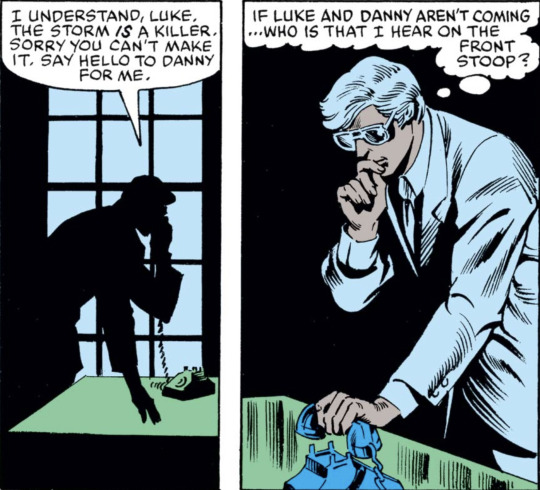#Vol 206
Explore tagged Tumblr posts
Text

[2]

In which we all wish we were Fai just for a moment.
#Fai thank goodness you married this man#IF YOU DIDN’T I WOULD HAVE#UGH I love this#Liveblogging the reservoir chronicle#Tsubasa#Vol 206#Kurogane#Evil Wolverine#I’m glad Kurogane gets an individual stand off moment#And he boils it down to SHUT UP#Which I have been DESPERATELY wanting him to do for YEARS#Also I love Kurogane goading him#Since we all know Evil Wolverine ISN’T going to do that#And likely CANT do that#And is going to do some more bullshit instead
78 notes
·
View notes
Text

11 notes
·
View notes
Text








Lee Na-eun (April) for 1st Look Vol. 206 October 2020
2 notes
·
View notes
Text






EXO KAI x Bobbi Brown for 1st Look Magazine Vol 206
13 notes
·
View notes
Text

Kim Dong Hwan design reference, for Garou: Mark of the Wolves.
Arcadia Vol. 1 (Jan. 8, '00), pg. 206
22 notes
·
View notes
Note
You know, I never considered Wondermagic as a ship, but I’m curious now. What drew you to them?
HI!! so pretty much these comics: JLA (vol. 1) #202 + Wonder Woman #291-293 Vol. 1, JLA (vol. 1) #171-178, JLA (vol.1) #206-219, plus many interactions in justice league: dark! tbf there are many wondermagic interactions in zee’s whole joining the justice league arc but. these are like the wondermagic holy texts! I’ve heard there’s a zatanna appearance in a newish wonder woman story in tom kings run but I honestly don’t want to read it 😭
7 notes
·
View notes
Text






waiting for Kai 68/641 ↳ Kai x Bobbi Brown for 1st Look Magazine Vol.206
#waiting for nini#exosnet#kpopco#kvanity#ultkpop#ksoloists#usermusic#usermau#usermolly#useranusia#userjoanna#useroro#userresa#lisanamjoon#ceeblr#melontrack#my*#kai#exo
139 notes
·
View notes
Text
I'm gonna do it.
I'm going to reread I'll Think of This as a Vacation and Enjoy It, aka the original Gentle Noble webnovel.
There are currently 206 chapters on Syosetu (192 chapters of the main story plus side stories), which means if I read 17 chapters a month, or 4~5 a week, I can do it.
I'm going to do this and take NOTES so that I can write up summaries of each chapter and record such things as characters, labyrinths and labyrinth goods, and information about the magic systems.
Obviously, this will eventually get into spoiler territory for those reading the translated manga. They're gonna be long posts anyway, so they'll be under readmores, and I'll note where chapters line up with the manga and when we pass what's been released. (Reminder that manga vol 10 is coming January 28th, 2025!)
Happy 2025, Gentle Noble fandom! Let's enjoy even more adventures with Lizel, Gil, Eleven, and the rest this year!
#a gentle noble's vacation recommendation#a mild noble's vacation suggestion#穏やか貴族の休暇のすすめ。#odayaka kizoku no kyuuka no susume#休暇#manga#japanese webnovel#i'll think of this as a vacation and enjoy it#休暇だと思って楽しみます。#hachi no hanashi#tbh it's fine if it takes me more than a year. ofc#esp depending on how certain things go for me this year#but nice to start with a goal#i'd like to at least get through the same stuff the manga has covered#this is where i wish i had a website#set it up nice#i should really sit and think about what i want that to look like and check out#some class or youtube videos on website building#i'm more of a computer person but most people use mobile these days so gotta take that into account with the design
10 notes
·
View notes
Text

I.3.8 Do anarchists seek “small autonomous communities, devoted to small scale production”?
No. The idea that anarchism aims for small, self-sufficient, communes is a Leninist slander. They misrepresent anarchist ideas on this matter, suggesting that anarchists seriously want society based on “small autonomous communities, devoted to small scale production.” In particular, they point to Kropotkin, arguing that he “looked backwards for change” and “witnessed such communities among Siberian peasants and watchmakers in the Swiss mountains.” [Pat Stack, “Anarchy in the UK?”, Socialist Review, no. 246] Another Leninist, Donny Gluckstein, makes a similar assertion about Proudhon wanting a federation of “tiny economic units”. [The Paris Commune, p. 75]
While it may be better to cover this issue in section H.2, we discuss it here simply because it relates directly to what an anarchist society could look like and so it allows us to that more fully.
So what do anarchists make of the assertion that we aim for “small autonomous communities, devoted to small scale production”? Simply put, we think it is nonsense (as would be quickly obvious from reading anarchist theory). Indeed, it is hard to know where this particular anarchist “vision” comes from. As Luigi Fabbri noted, in his reply to an identical assertion by the leading Bolshevik Nikolai Bukharin, ”[i]t would be interesting to learn in what anarchist book, pamphlet or programme such an ‘ideal’ is set out, or even such a hard and fast rule!” [“Anarchy and ‘Scientific’ Communism”, pp. 13–49, The Poverty of Statism, Albert Meltzer (ed.), p. 21]
If we look at, say, Proudhon, we soon see no such argument for “small scale” production. For Proudhon, ”[l]arge industry … come to us by big monopoly and big property: it is necessary in the future to make them rise from the [workers] association.” [quoted by K. Steven Vincent, Proudhon and the Rise of French Republican Socialism, p. 156] In fact, The Frenchman explicitly rejected the position Stack inflicts on him by arguing that it “would be to retrograde” and “impossible” to wish “the division of labour, with machinery and manufactures, to be abandoned, and each family to return to the system of primitive indivision, — that is, to each one by himself, each one for himself, in the most literal meaning of the words.” [System of Economic Contradictions, p. 206] As historian K. Steven Vincent correctly summarises:
“On this issue, it is necessary to emphasise that, contrary to the general image given in the secondary literature, Proudhon was not hostile to large industry. Clearly, he objected to many aspects of what these large enterprises had introduced into society. For example, Proudhon strenuously opposed the degrading character of … work which required an individual to repeat one minor function continuously. But he was not opposed in principle to large-scale production. What he desired was to humanise such production, to socialise it so that the worker would not be the mere appendage to a machine. Such a humanisation of large industries would result, according to Proudhon, from the introduction of strong workers’ associations. These associations would enable the workers to determine jointly by election how the enterprise was to be directed and operated on a day-to-day basis.” [Op. Cit., p. 156]
Moreover, Proudhon did not see an anarchist society as one of isolated communities or workplaces. Like other anarchists, as we discussed in section I.3.4, Proudhon saw a free society’s productive activity centred around federations of syndicates.
This vision of a federation of workplaces can also be found in Bakunin’s writings: “The future organisation of society must proceed from the bottom up only, through free association or federations of the workers, into their associations to begin with, then into communes, regions, nations and, finally, into a great international and universal federation.” [No Gods, No Masters, vol. 1, p. 176] Like Proudhon, Bakunin also explicitly rejected the idea of seeking small-scale production, arguing that “if [the workers] tried to divide among themselves the capital that exists, they would … reduce to a large decree its productive power.” Therefore the need was for “the collective property of capital” to ensure “the emancipation of labour and of the workers.” [The Basic Bakunin, p. 91] Bakunin, again like Proudhon, considered that ”[i]ntelligent free labour will necessarily be associated labour” as under capitalism the worker “works for others” and her labour is “bereft of liberty, leisure and intelligence.” Under anarchism, “the free productive associations” would become “their own masters and the owners of the necessary capital” and “amalgamate among themselves” and “sooner or later” will “expand beyond national frontiers” and “form one vast economic federation.” [Michael Bakunin: Selected Writings, pp. 81–3]
Nor can such a vision be attributed to Kropotkin. While, of course, supporting decentralisation of power and decision making as did Proudhon and Bakunin, he did not reject the necessity of federations to co-ordinate activity. As he put it, the “commune of tomorrow will know that it cannot admit any higher authority; above it there can only be the interests of the Federation, freely accepted by itself as well as the other communes”/ For anarchists the commune “no longer means a territorial agglomeration; it is rather a generic name, a synonym for the grouping of equals which knows neither frontiers nor walls … Each group in the Commune will necessarily be drawn towards similar groups in other communes; they will come together and the links that federate them will be as solid as those that attach them to their fellow citizens.” [Words of a Rebel, p. 83 and p. 88] Nor did he reject industry or machinery, stating he “understood the poetry of machinery” and that while in “our present factories, machinery work is killing for the worker” this was “a matter of bad organisation, and has nothing to do with the machine itself.” [Memiors of a Revolutionist, p. 111]
Kropotkin’s vision was one of federations of decentralised communities in which production would be based on the “scattering of industries over the country — so as to bring the factory amidst the fields … agriculture … combined with industry … to produce a combination of industrial with agricultural work.” He considered this as “surely the next step to be made, as soon as a reorganisation of our present conditions is possible” and “is imposed by the very necessity of producing for the producers themselves.” [Fields, Factories and Workshops Tomorrow, pp. 157–8] He based this vision on a detailed analysis of current economic statistics and trends.
Kropotkin did not see such an anarchist economy as being based around the small community, taking the basic unit of a free society as one “large enough to dispose of a certain variety of natural resources — it may be a nation, or rather a region — produces and itself consumes most of its own agricultural and manufactured produce.” Such a region would “find the best means of combining agriculture with manufacture — the work in the field with a decentralised industry.” Moreover, he recognised that the “geographical distribution of industries in a given country depends … to a great extent upon a complexus of natural conditions; it is obvious that there are spots which are best suited for the development of certain industries … The[se] industries always find some advantages in being grouped, to some extent, according to the natural features of separate regions.” [Op. Cit., p. 26, p. 27 and pp. 154–5]
Kropotkin stressed that agriculture “cannot develop without the aid of machinery and the use of a perfect machinery cannot be generalised without industrial surroundings … The village smith would not do.” He supported the integration of agriculture and industry, with “the factory and workshop at the gates of your fields and gardens” in which a “variety of agricultural, industrial and intellectual pursuits are combined in each community” to ensure “the greatest sum total of well-being.” He thought that “large establishments” would still exist, but these would be “better placed at certain spots indicated by Nature.” He stressed that it “would be a great mistake to imagine industry ought to return to its hand-work stage in order to be combined with agriculture. Whenever a saving of human labour can be obtained by means of a machine, the machine is welcome and will be resorted to; and there is hardly one single branch of industry into which machinery work could not be introduced with great advantage, at least at some of the stages of the manufacture.” [Op. Cit., p. 156, p. 197, p. 18, pp. 154–5 and pp. 151–2]
Clearly Kropotkin was not opposed to large-scale industry for “if we analyse the modern industries, we soon discover that for some of them the co-operation of hundred, even thousands, of workers gathered at the same spot is really necessary. The great iron works and mining enterprises decidedly belong to that category; oceanic steamers cannot be built in village factories.” However, he stressed that this objective necessity was not the case in many other industries and centralised production existed in these purely to allow capitalists “to hold command of the market” and “to suit the temporary interests of the few — by no means those of the nation.” Kropotkin made a clear division between economic tendencies which existed to aid the capitalist to dominate the market and enhance their profits and power and those which indicated a different kind of future. Once we consider the “moral and physical advantages which man would derive from dividing his work between field and the workshop” we must automatically evaluate the structure of modern industry with the criteria of what is best for the worker (and society and the environment) rather than what was best for capitalist profits and power. [Op. Cit., p. 153, p. 147 and p. 153]
Clearly, Leninist summaries of Kropotkin’s ideas on this subject are nonsense. Rather than seeing “small-scale” production as the basis of his vision of a free society, he saw production as being geared around the economic unit of a nation or region: “Each region will become its own producer and its own consumer of manufactured goods … [and] its own producer and consumer of agricultural produce.” Industry would come to the village “not in its present shape of a capitalist factory” but “in the shape of a socially organised industrial production, with the full aid of machinery and technical knowledge.” [Op. Cit., p. 40 and p. 151]
Industry would be decentralised and integrated with agriculture and based around communes, but these communes would be part of a federation and so production would be based around meeting the needs of these federations. A system of rational decentralisation would be the basis of Kropotkin’s communist-anarchism, with productive activity and a free society’s workplaces geared to the appropriate level. For those forms of industry which would be best organised on a large-scale would continue to be so organised, but for those whose current (i.e., capitalist) structure had no objective need to be centralised would be broken up to allow the transformation of work for the benefit of both workers and society. Thus we would see a system of workplaces geared to local and district needs complementing larger factories which would meet regional and wider needs.
Anarchism rejects the idea of small-scale production and isolated communes and, as we discussed in section H.2.3, it does not look backwards for its ideal. The same applies to other forms of libertarian socialism with, for example, G.D.H. Cole arguing that we “cannot go back to ‘town economy’, a general regime of handicraft and master-craftmanship, tiny-scale production. We can neither pull up our railways, fill our mines, and dismantle our factories nor conduct our large-scale enterprises under a system developed to fit the needs of a local market and a narrowly-restricted production.” The aim is “to reintroduce into industry the communal spirit, by re-fashioning industrialism in such a way as to set the communal motives free to co-operate.” [Guild Socialism Reststed, pp. 45–6 and p. 46]
The obvious implication of Leninist comments arguments against anarchist ideas on industrial transformation after a revolution is that they think that a socialist society will basically be the same as capitalism, using the technology, industry and industrial structure developed under class society without change (as noted in section H.3.12, Lenin did suggest that was the case). Needless to say, capitalist industry, as Kropotkin was aware, has not developed neutrally nor purely because of technical needs. Rather it has been distorted by the twin requirements to maintain capitalist profits and power. One of the first tasks of a social revolution will be to transform the industrial structure, not keep it as it is. You cannot use capitalist means for socialist ends. So while we will “inherent” an industrial structure from capitalism it would be the greatest possible error to leave it unchanged and an even worse one to accelerate the processes by which capitalists maintain and increase their power (i.e. centralisation and concentration) in the name of “socialism.”
We are sorry to have laboured this point, but this issue is one which arises with depressing frequency in Marxist accounts of anarchism. It is best that we indicate that those who make the claim that anarchists seek “small scale” production geared for “small autonomous communities” simply show their ignorance. In actually, anarchists see production as being geared to whatever makes most social, economic and ecological sense. Some production and workplaces will be geared to the local commune, some will be geared to the district federation, some to the regional federation, and so on. It is for this reason anarchists support the federation of workers’ associations as the means of combining local autonomy with the needs for co-ordination and joint activity. To claim otherwise is simply to misrepresent anarchist theory.
Finally, it must be psychologically significant that Leninists continually go on about anarchists advocating “small” and “tiny” workplaces. Apparently size does matter and Leninists think their productive units are much, much bigger than anarchist ones. As has been proven, anarchists advocate appropriately sized workplaces and are not hung-up about their size. Why Leninists are could be a fruitful area of research...
#anarchist society#practical#practical anarchism#practical anarchy#faq#anarchy faq#revolution#anarchism#daily posts#communism#anti capitalist#anti capitalism#late stage capitalism#organization#grassroots#grass roots#anarchists#libraries#leftism#social issues#economy#economics#climate change#climate crisis#climate#ecology#anarchy works#environmentalism#environment#solarpunk
7 notes
·
View notes
Text

[9]
I fucking love them.
Expressing a desire for extreme violence as a fun bonding activity for married couples! Try it today!

OH AND ALSO THE SYAORANS. YES THAT IS ALSO RELEVANT, and/or probably the main actual focus of what’s going on here still!
BUT STILL. A WHOLE CHAPTER OF BATTLE HUSBANDS.
THANK YOU CLAMP I LOVED IT GREATLY. COULD NOT HAVE LOVED IT MORE
#What a way for this to go#DANGER FLIRTATION FIGHT ACTIVATED#Liveblogging the reservoir chronicle#Tsubasa#Vol 206#Kurogane#Fai#Syaoran#Lava Lamp Guy#Oh this was wonderful#BATTLE HUSBANDS BATTLE HUSBANDS
58 notes
·
View notes
Photo

💕 Sparklecare Update 💕
VOL 3: Pages 206-208 🌈 Click here to read!
✨ Support us on Patreon!
✨ Updates Mondays & Thursdays
106 notes
·
View notes
Text

Daredevil vol. 1 #206 by Denny O'Neil, David Mazzucchelli, Christie Scheele, Danny Bulanadi, and Joe Rosen
Matt Murdock invites Luke and Danny to his holiday party, but sadly*, they can't come.
*Sadly because the party devolves into a massive fight, and Luke and Danny love fights.
26 notes
·
View notes
Text

I apologise in advance for how feral I'll be when Vol 3 of the LNs comes out and gets translated. kunigami lore aaaaaaaaaaa
Hoshi shared translations of the titles yesterday! So to fuel some hype, here's some speculation about what each part of the light novel will focus on.
Here's an index of existing fan translations of the two published light novels. I'd recommend reading them: they're short and enjoyable. Although a lot of the content has been covered or referenced by the mangas and Egoist Bible, there's some new trivia about your faves in there too like baby Isagi being able to predict the weather 🌦️

1. Niko Ikki: "Immersion"

I'm not a Niko stan (I don't dislike him! I just have other faves), so this is the hardest entry for me to conceptualise in terms of theme or story. If anyone with a better grasp on his character would like to chip in, be my guest!
Niko has the following key character traits:
➡️ he's the youngest of the characters introduced so far;
➡️he's something of an underdog;
➡️ he enjoy a particular rivalry with Isagi, as (in Isagi's words) they have the same eyes and brain;
➡️ Niko appears to be fairly introverted, enjoying games and anime/manga; and
➡️ A defining trait is his insecurity about his forehead.
Some further thoughts on what Niko's entry might feature:
🔵 "Immersion" may refer to how Niko loses himself in football: both in terms of how he goes unnoticed by his opponents and how involved he gets in the sport. That's my best guess! I'm stumped otherwise.
🔵 I anticipate there will be some rival or potential bully Niko has to overcome, using his wits and intelligence. Maybe he has to prove himself to a dismissive school football club?
🔵 His tactic early in Blue Lock is to use more physical players (such as Oikawa and Zantetsu) to score goals for his team, acting as the playmaker. The LN may elaborate on how he developed this strategy.
🔵 The forehead thing just has to be a teenage complex around acne or something, right? I don't think it's more serious than that, given how much the writer and mangaka joke about it (see: forehead kanji on the Vol 25 manga cover).
🔵 I don't think we'll be seeing Niko spotting mosquitos across the room... but the LN will likely comment on his good vision/spacial awareness also.
2. Kunigami Rensuke: "Rule"
Kunigami's light novel will be a prequel, same as all the others. While we won't get any hints about Wild Card (🥹) it's likely we'll learn about:
🟠 How his desire to become a football superhero came to be. The main manga suggests this came from him watching footballers on TV while young.
🟠 His family. Kunigami is a middle child, with two sisters. What's their family dynamic like? Does he get on with his sisters and parents?
▶️ A theory: being the middle child and only boy is one reason Kunigami goes by the saying, "fair and square". His parents enforced that message so their three children would get along!
🟠 Explanation for his personality traits. The LN might explore the rationale for his protective nature. Perhaps Kunigami was raised with the notion of looking out for his sisters, which extends to his friends and teammates in Blue Lock.
🟠 The LN will likely show how Kunigami fared as a striker in high school. Given how good he is starting out in Blue Lock, dude must have been a beast on his school team.
Overall, I'm praying Kunigami's entry is light-hearted. Our grumpy orange goes through enough angst in canon - he deserves some happiness before coming to Blue Lock 😭 I think the odds of this are actually pretty good, because if there's an angsty entry in this volume, then that's gonna be...
🟠 Lastly, the title (Rule) likely refers to his "fair and square" motto. Kunigami lives a very regimented life in Blue Lock (eat, train, play football, train some more, shower and sleep). Perhaps the focus of the LN will be how he developed that willpower and dedication.

3. Hiori Yo: "NEW GAME"
Hiori's LN entry is the easiest one to anticipate, since chapter 206 gave a fairly detailed account of his upbringing and family life.
"NEW GAME" is likely in reference to his enjoyment of video games (how these acted as a means of escape for him) as well as how Blue Lock represented a new life away from his overbearing parents.
Here are some of my expectations (sorry Hiori 💔) for his entry:
🔵 a retelling of the events of chapter 206, focussing on Hiori's injury and his discovery of his parents' discontent.
🔵 an exploration of the impact his pushy parents had on his personality and enjoyment of sports.
🔵 backstory about Hiori and Karasu's friendship/rivalry! For example, did Karasu ever target Hiori as the "weakest link" of a team? I'd be surprised if he doesn't show up - the Wanima twins appeared in Chigiri's novel, as did Sae in Rin's.
⚽⚽⚽
I'd love to hear people's thoughts about this! I'm looking forward to these getting a release, even if it'll be some time before I can actually read them. The illustrations alone are a treat - in the first two volumes, these were completed by Sannomiya-sensei, the mangaka for Episode Nagi.
#blue lock#bllk#blue lock spoilers#bllk light novel#bllk analysis#niko ikki#kunigami rensuke#hiori yo#mine
53 notes
·
View notes
Text

Survivor References, Vol. 1
Hey folks! If you've been keeping up with my last art posts, you've probably already seen these. They're a set of concept sketches for a still in-development project, and though it's a long way from public release, I wanted to share some information about it! More below the cut.
Eda's design is based heavily on these concepts for Watching and Dreaming by Luz Batista, especially the second one. Her outfit is intended to be more practical than stylish, though the cape is absolutely something she wears to honor her old maroon dress. Her shoulder pauldron is fashioned from the armor of a Coven Scout Captain, salvaged from the ruins of Police Precinct 206 in Latassia. King's mom and sister got to have cloaks, so he decided he wanted one too! His cloak is hand-made, which Eda had stitched together from a collection of old, unused blankets. The Golden Pendant is removed from his collar and used to hold the cloak together. Luz recovered her old Witches Wool cloak not long after the Day of Unity, and has been wearing it since due to the heightened protection it offers, hence the wear and tear it's undergone.
Now, I'm going to preface that this project is still in very early development, still in the scripting phase, and everything regarding it is subject to change. However, I do want to share some information about it. The working and likely final title is The Children of Hope. It's a story set in a divergent Alternate Universe, where King is never knocked down the stairs of the bridge, and thus, never meets the collector. As a consequence, the Day of Unity isn't stopped. It's a very dark universe compared to cannon, but not all is so bleak - four years after the Day of Unity, Luz is given a vision of a powerful, incredibly complex spell. One that can send memories back through time, comparable to something like Time Travel. Using this spell, she and her surviving friends-slash-family are able to return to the start of Season One, and completely flip the playing field in their favor.
Again, I don't have much to share about the Alternate Universe - I'm still planning it out, after all! - but I'm excited to put more work into it over time, in between other projects. I hope, when it's eventually developed enough to warrant a release, that you'll enjoy reading it! Until then, I'll share any big content updates on it over time. Have a good day, and thanks for reading all my rambling!
#the owl house#the owl house au#eda clawthorne#king clawthorne#luz noceda#toh#toh au#eda the owl lady#edalyn clawthorne#eda toh#eda the owl house#luz toh#luz the owl house#king toh#king the owl house#anomnomart
15 notes
·
View notes
Text
Kaidou manga panels I like: (pt 366)
Injury: feat. Saiki, Kaidou's mom, Kuniharu, and Kurumi


From: vol 20 ch 206
#saiki k#tdlosk#shun kaidou#kaidou shun#kusuo saiki#saiki kusuo#kaidou's mom#kuniharu saiki#saiki kuniharu#kurumi saiki#saiki kurumi#otani shiho I will find you
13 notes
·
View notes